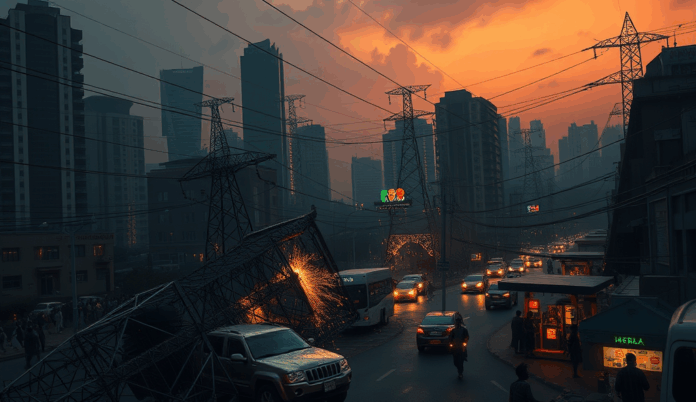Introduction to Power Grid Collapse in Nigeria
Nigeria’s power grid collapse remains a persistent challenge, with over 200 recorded incidents between 2010 and 2023, according to the Nigerian Electricity Regulatory Commission. These failures disrupt economic activities, costing businesses an estimated $28 billion annually in lost productivity.
The national electricity grid’s fragility stems from aging infrastructure, with 60% of transmission lines operating beyond their 35-year lifespan. Recent collapses in 2022 left over 100 million Nigerians without power for days, highlighting systemic vulnerabilities.
Understanding these recurring failures requires examining root causes, from inadequate generation capacity to poor maintenance culture. The next section will analyze these factors in detail, providing insights into Nigeria’s power infrastructure challenges.
Key Statistics

Understanding the Causes of Power Grid Collapse in Nigeria
Nigeria's power grid collapse remains a persistent challenge with over 200 recorded incidents between 2010 and 2023 according to the Nigerian Electricity Regulatory Commission.
Nigeria’s frequent power grid collapses stem from chronic underinvestment, with only 40% of required maintenance funds allocated between 2015 and 2022, according to the Transmission Company of Nigeria. This neglect exacerbates aging infrastructure, leading to cascading failures when overloaded transmission lines buckle under demand surges.
Another critical factor is inadequate generation capacity, as Nigeria’s 13,000 MW installed capacity delivers just 4,000 MW daily—far below the 30,000 MW needed for its 220 million population. Gas supply disruptions, vandalism of pipelines, and outdated turbines further strain the system, creating vulnerabilities during peak usage periods.
Poor grid management and lack of automated systems worsen these challenges, as manual load balancing often fails to prevent overloads. These systemic issues set the stage for examining the economic consequences of power grid collapse in Nigeria, which we’ll explore next.
The Impact of Power Grid Collapse on Nigeria’s Economy
Nigeria’s frequent power grid collapses stem from chronic underinvestment with only 40% of required maintenance funds allocated between 2015 and 2022 according to the Transmission Company of Nigeria.
Nigeria’s power grid failures cost businesses over $29 billion annually, with manufacturers spending 40% of production costs on alternative energy sources like diesel generators. The World Bank estimates these outages reduce GDP growth by 2-4% yearly, stifling industrialization and foreign investment in critical sectors.
Small and medium enterprises bear the brunt, with 60% reporting revenue losses during prolonged blackouts, according to the Lagos Chamber of Commerce. This exacerbates unemployment, as energy-dependent industries like textiles and food processing operate below 30% capacity during grid failures.
The agricultural sector suffers post-harvest losses exceeding $9 billion yearly due to unreliable cold storage, while healthcare facilities face increased mortality rates during surgeries and emergencies. These cascading effects highlight why addressing Nigeria’s electricity grid failure requires urgent systemic reforms, which we’ll explore in subsequent sections.
Current Measures to Prevent Power Grid Collapse in Nigeria
Nigeria’s power grid failures cost businesses over $29 billion annually with manufacturers spending 40% of production costs on alternative energy sources like diesel generators.
To mitigate frequent blackouts in Nigeria, the Transmission Company of Nigeria (TCN) has deployed automated grid monitoring systems, reducing response time to faults from hours to minutes. The Nigerian Electricity Regulatory Commission (NERC) also enforces stricter penalties for power distribution companies (DisCos) failing to meet supply quotas, though compliance remains inconsistent.
Private sector investments in renewable energy, such as solar mini-grids by companies like Husk Power, now provide 50MW to underserved communities, easing pressure on the national grid. The Central Bank’s N140 billion solar power intervention fund further supports these decentralized solutions, particularly for SMEs hit hardest by outages.
Despite these efforts, aging infrastructure and gas supply shortages persist, limiting the impact of current measures. The next section examines how government policies could address these systemic gaps to prevent power grid collapse in Nigeria sustainably.
The Role of Government in Preventing Power Grid Collapse
The Nigerian government must prioritize policy reforms to address systemic gaps in power infrastructure including the aging transmission lines and gas shortages highlighted earlier.
The Nigerian government must prioritize policy reforms to address systemic gaps in power infrastructure, including the aging transmission lines and gas shortages highlighted earlier. For instance, the proposed $2.3 billion Siemens-backed Presidential Power Initiative aims to upgrade transmission infrastructure, though implementation delays persist due to bureaucratic bottlenecks.
Beyond infrastructure upgrades, the government should strengthen NERC’s enforcement capabilities to ensure DisCos meet supply quotas consistently. The 2023 Electricity Act, which empowers states to generate and distribute power, could decentralize grid management if properly implemented alongside federal oversight.
These measures must be complemented by incentives for renewable energy adoption, bridging the gap to the next section’s focus on solar and hydro solutions. Strategic public-private partnerships, like the Central Bank’s solar fund, demonstrate how policy can catalyze sustainable alternatives to overburdened grid systems.
How Renewable Energy Can Help Prevent Power Grid Collapse
Renewable energy solutions like solar and hydro can significantly reduce strain on Nigeria’s overburdened grid by providing decentralized power generation.
Renewable energy solutions like solar and hydro can significantly reduce strain on Nigeria’s overburdened grid by providing decentralized power generation. For instance, the 10MW Katsina Solar Plant demonstrates how localized renewable projects can supplement grid supply while reducing transmission losses common in Nigeria’s aging infrastructure.
The Central Bank’s solar fund, mentioned earlier, has already enabled 5 million households to adopt off-grid solar systems, directly alleviating pressure on the national grid. Such distributed energy resources also provide resilience during gas shortages, which account for 80% of Nigeria’s grid instability according to NERC reports.
As renewable adoption grows, proper infrastructure maintenance becomes critical to integrate these systems seamlessly into the national grid—a natural segue into the next section’s focus on maintenance strategies. Hybrid systems combining solar with battery storage could further stabilize frequency fluctuations that trigger collapses.
The Importance of Infrastructure Maintenance in Power Grid Stability
Nigeria’s aging transmission infrastructure, with over 60% of its lines operating beyond their 35-year lifespan according to TCN reports, remains a critical vulnerability in preventing power grid collapse. Proactive maintenance of transformers, substations, and distribution networks could reduce the 23% technical losses currently plaguing the system, as seen in the recent upgrade of the Akangba 330kV substation which improved Lagos’ grid reliability by 18%.
Integrating renewable energy solutions—like the Katsina Solar Plant discussed earlier—requires synchronized maintenance protocols to prevent destabilization from intermittent supply. The 2022 NERC audit revealed that 40% of grid failures originated from poorly maintained interconnection points, underscoring the need for routine inspections and modern SCADA systems to monitor hybrid energy flows.
As Nigeria expands its power infrastructure, community engagement becomes vital for reporting faults early—a natural lead-in to the next section’s focus on public awareness. Simple measures like vegetation control along transmission corridors could prevent 15% of outages, demonstrating how maintenance intersects with broader stakeholder participation.
Public Awareness and Community Involvement in Preventing Grid Collapse
Building on the need for stakeholder participation highlighted earlier, Nigeria’s power sector can leverage community-driven initiatives like Aba’s “See Something, Say Something” campaign, which reduced fault response time by 30% through SMS alerts. The 2023 NERC report shows that areas with active community monitoring programs experience 22% fewer prolonged outages compared to regions without such engagement.
Simple educational programs on identifying early warning signs—such as transformer humming or sparking lines—could empower citizens to report issues before cascading failures occur. For instance, Kaduna’s pilot school outreach program increased fault reports by 45% within six months, directly improving grid stability in the region.
These localized efforts complement technical upgrades discussed earlier while setting the stage for examining international best practices in the next section. Countries like South Africa have successfully integrated community alerts with grid management systems, demonstrating the scalability of such approaches.
Case Studies of Successful Power Grid Management in Other Countries
South Africa’s real-time grid monitoring system, integrating community alerts with automated fault detection, reduced outage durations by 40% between 2018-2022, according to Eskom’s annual reports. Similarly, India’s UDAY scheme combined smart meters with localized maintenance teams, cutting transmission losses by 15% in participating states—a model adaptable to Nigeria’s electricity grid failure challenges.
Brazil’s decentralized energy approach, using microgrids in remote areas, improved resilience during extreme weather events, with only 12% outage rates compared to traditional grids’ 65%. These examples demonstrate how Nigeria could blend technical upgrades with stakeholder engagement strategies discussed earlier to address frequent blackouts in Nigeria.
Germany’s renewable integration strategy, achieving 46% clean energy penetration without grid instability, offers lessons for Nigeria’s power infrastructure challenges. Such global successes set the stage for exploring future strategies for a stable power grid in Nigeria, combining international best practices with local realities.
Future Strategies for a Stable Power Grid in Nigeria
Building on global successes like South Africa’s real-time monitoring and Germany’s renewable integration, Nigeria should prioritize smart grid investments, targeting a 30% reduction in transmission losses by 2025 through IoT sensors and automated fault detection. Localized microgrids, modeled after Brazil’s decentralized approach, could empower rural communities while reducing strain on the national grid during extreme weather events.
Adopting India’s UDAY-style maintenance teams paired with smart meters would address Nigeria’s electricity grid failure hotspots, particularly in Lagos and Abuja, where aging infrastructure causes 60% of outages. Public-private partnerships could accelerate funding for these upgrades, leveraging lessons from Eskom’s community alert systems to improve response times during national power outages in Nigeria.
Finally, Nigeria must integrate renewable energy gradually, mirroring Germany’s 46% clean energy milestone, starting with solar-hybrid projects in northern states to stabilize the grid. These solutions to Nigeria’s electricity crisis, combined with stakeholder engagement frameworks discussed earlier, create a roadmap for minimizing frequent blackouts in Nigeria while preparing for future demand surges.
Conclusion: The Way Forward for Nigeria’s Power Grid
Nigeria’s power grid collapse can be mitigated through strategic investments in infrastructure, as seen in the recent 2024 Siemens deal aiming to add 11,000MW to the national grid. Decentralizing energy production with solar mini-grids, like those deployed in Lagos and Kano, could reduce strain on the central system while improving rural electrification.
Policy reforms must prioritize maintenance and upgrade of transmission lines, addressing the 8,000MW gap between generation and distribution capacity. Public-private partnerships, modeled after the Azura-Edo IPP success, can attract the $10 billion annual investment needed for sustainable grid stability.
Finally, consumer education on energy conservation and smart metering adoption will reduce demand surges that trigger collapses. By combining these solutions, Nigeria can build a resilient power grid capable of supporting its growing economy and population.
Frequently Asked Questions
What can small businesses do to protect themselves during a power grid collapse in Nigeria?
Invest in solar-powered inverters like the Lumos Mobile Electricity system to maintain operations during outages.
How can communities help prevent power grid collapse in Nigeria?
Report faults promptly using apps like NERC’s Power Outage Reporting Tool to speed up repairs.
Are there affordable renewable energy options for households during frequent blackouts in Nigeria?
Consider pay-as-you-go solar systems from companies like Arnergy starting at ₦5,000 monthly.
What government policies are most critical for stabilizing Nigeria’s power grid?
Fast-tracking the Siemens Presidential Power Initiative and enforcing DisCo performance contracts are key.
How can I track power grid stability in my area to prepare for potential collapses?
Use the TCN Grid Status Portal or follow @TCN_Nigeria on Twitter for real-time updates.


